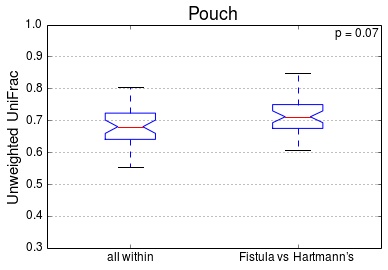A. Trecartin1, J. Debelius2, M. Wieck1, R. Spurrier3, R. Knight2, T. Grikscheit1 1Children’s Hospital Los Angeles,Pediatric Surgery,Los Angeles, CA, USA 2University Of California – San Diego,Pediatrics And Computer Science & Engineering,San Diego, CA, USA 3Cedars-Sinai Medical Center,Surgery,Los Angeles, CA, USA
Introduction:
Pediatric surgical emergencies often result in high levels of antibiotic use and intestine may be left in discontinuity postoperatively with either uni-directional [Hartmann’s pouch (HP)] or bi-directional [mucous fistula (MF)] luminal flow. We hypothesized that phylogenetic diversity would not vary between the two despite severe perturbations including antibiotics, surgery and disease.
Methods:
Pediatric surgical specimens including HP (5) and MF (8) were swabbed under sterile conditions for 16s rRNA characterization. A Kruskal-Wallis test was used to compare HP/MF groups with each other and with a larger data pool encompassing a wide range of surgical diagnoses to obtain alpha and beta-diversity. Weighted and unweighted UniFRAc distances were calculated using permanova and anosim tests. UniFRAc distances were measured between the HP or MF (5 pairs each) and the specimen in continuity with the same patient’s fecal stream. A g-test was also used to identify elevated operational taxonomic units (OTUs).
Results:
There was no significant difference in alpha-diversity (p=0.38) between HP/MF or beta-diversity (p=0.07) between HP/MF and all samples (figure). There was no difference between HP and MF paired samples for both weighted and unweighted UniFRAc distances (p=0.76 and 0.74). Also, no statistically significant difference was found in levels of OTUs between groups.
Conclusion:
There is no statistically significant difference between HP and MF despite changes in luminal flow in the context of drastic environmental shifts such as antibiotic use, surgical diseases and host factors. Consequently, the effect of luminal flow on the microbiome should not alter the surgeon’s choice of operation.
